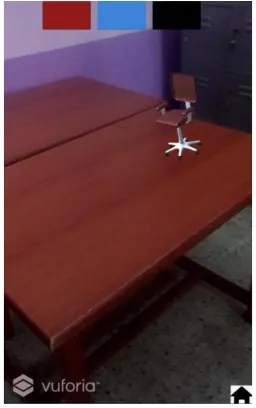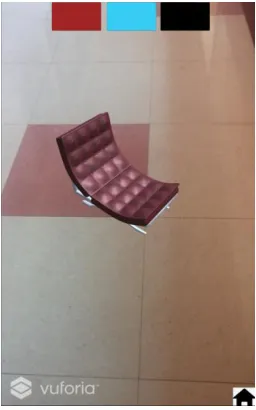© 2017, IRJET | Impact Factor value: 5.181 | ISO 9001:2008 Certified Journal | Page 1414
Furniture Arrangement Using Augmented Reality
Ms. Kirti Motwani
1, Shweta Sharma
2, Dhanashree Pawar
31
Ms.Kirti Motwani, Xavier Institute of Engineering, Mahim, Mumbai
2Shweta Sharma, Xavier Institute of Engineering, Mahim, Mumbai
3Dhanashree Pawar, Xavier Institute of Engineering, Mahim, Mumbai
---***---
Abstract -
Augmented reality aids people with visual effectsthat relate to the environment of the space and with this concept people can view the furniture in the room without actually placing it in the area. The user interactively moves furniture piece using our application without actually having to arrange the furniture which is a highly tedious task. We develop an interactive system for furniture arrangements which includes translation, rotation and scaling of the 3D objects, as per the choice of the user. Thus, the user can experience different furniture arrangements through our application which minimizes the user’s time and effort.
Keywords: Augmented Reality, furniture, interior design,
three-dimensional spacing, rendering.
1. INTRODUCTION
Furniture arrangement in house or in office can be a tedious work if there are too many furniture to be placed in the room or simply people don’t have any idea how to do layout of the furniture. People can either draw up the room and furniture in paper or use computer applications that assist people or they can just arrange furniture right away to see how it looks and fits in the room. In our proposed system, we will use the concept of AR to help people view the furniture in their room without actually placing it in the area.We present an interactive furniture layout Android application that helps users arrange their furniture by simple actions like sliding, pinch-in, pinch-out, etc. This will greatly minimize the user’s time and effort.
2. THEORY
Augmented Reality (AR) allows virtual objects to be combined with a real world representation. The three key characteristics of AR have been identified to be: (1) combining real and virtual images, (2) the virtual imagery is registered with the real world, and (3) real time interaction of both virtual and real objects. During the last decades, research in AR focused on the development of techniques to provide such a user experience. Applications of AR can now be found in various domains such as medicine or games [14]. With the sophistication of mobile devices the new field of mobile AR has emerged with its own challenges.
The main limitations of current mobile devices for AR are the limited input/output options, the screen size and the graphical/computational power. AR has often been opposed to pure virtual reality (VR) mainly in the domain of medical training and has shown to lead to a better perception of the task especially when coupled with haptic feedbacks. An AR based approach has recently been used as a new interaction technique to increase safety for industrial robots: the user can pre-visualize the moves of a robotic arm and display information regarding the current state of the motors using a head-mounted display.
Vuforia is an Augmented Reality Software Development Kit (SDK) for mobile devices that enables the creation of Augmented Reality applications. It uses Computer Vision technology to recognize and track planar images (Image Targets) and simple 3D objects, such as boxes, in real-time. Image Targets represent images that the Vuforia SDK can detect and track. Once the Image Target is detected, the SDK will track the image as long as it is at least partially in the camera’s field of view. Vuforia first detects "feature points" in your target image and then uses the data to compare the features in target image and the receiving frame from camera.
3. METHOD
[image:1.612.323.562.495.693.2]© 2017, IRJET | Impact Factor value: 5.181 | ISO 9001:2008 Certified Journal | Page 1415
3.1 Mesh Creation
[image:2.612.367.529.81.270.2]Desired furniture model is created.
Fig -3.1: Mesh
3.2 Creation of Seams and Mesh Unwrapping
A seam is where the ends of the image/cloth are sewn together i.e. we mark seams on our 3D mesh according to which the mesh is cut [13]. Cutting of the mesh model according to the seams marked results in various flattened-out pieces of the mesh which makes the process of texture creation easier. According to the seams marked, mesh is unwrapped for texture creation.
[image:2.612.85.241.152.332.2]Fig -3.2.1: Seams marked
Fig -3.2.1: Unwrapping mesh
3.3Texture Creation
Texture creation extends the known parts of the image to the unknown ones, and copies pixels of known regions to unknown ones [2]. Once the 3D shape of the furniture in the 2D image has been recovered in the view of camera, the mesh is re-projected onto the image plane. We then can apply the generated texture to the 3D shape and produce the final 3D model which is ready to be rearranged using scaling and rotation.
Fig -3.3: Texture creation
3.4 Mesh Rendering
[image:2.612.339.558.429.556.2] [image:2.612.82.242.465.633.2]© 2017, IRJET | Impact Factor value: 5.181 | ISO 9001:2008 Certified Journal | Page 1416
Fig -3.4: Final 3D model3.5 Translation, Rotation, Scaling
We compute translation vector in virtual 3D space in such a way that the drag amount is consistent with the displacement of the object on display [1].
3.5.1 Translation
In translation mode, the object can be displaced by swiping.
// Get the fingers we want to use
var fingers = LeanTouch.GetFingers(IgnoreGuiFingers, Requi redFingerCount);
// Calculate the screenDelta value based on fingersvar scree nDelta = LeanGesture.GetScreenDelta(fingers);
// Perform the translationTranslate(screenDelta);
Fig -3.5.1.1: Before translation
Fig -3.5.1.2: After translation
3.5.2 Rotation
In the rotation mode, the object rotates by dragging as making a circle around the center.
var fingers = LeanTouch.GetFingers(IgnoreGuiFingers, Req uiredFingerCount);
// Calculate the rotation values based on these fingers var center = LeanGesture.GetScreenCenter(fingers); var degrees =LeanGesture.GetTwistDegrees(fingers)
[image:3.612.386.514.332.536.2]© 2017, IRJET | Impact Factor value: 5.181 | ISO 9001:2008 Certified Journal | Page 1417
Fig -3.5.2.1: Before rotationFig -3.5.2.2: After rotation
3.5.3 Scaling
In scaling mode, the object expands or reduces by the operations of pinch-in or pinch-out using two fingers. var fingers = LeanTouch.GetFingers(IgnoreGuiFingers, Req
uiredFingerCount);
var scale = LeanGesture.GetPinchScale(fingers, WheelSensi tivity);
var screenCenter = LeanGesture.GetScreenCenter(fingers); Scale(scale, screenCenter);
[image:4.612.386.514.330.535.2]Fig -3.5.3.1: Before scaling
Fig -3.5.3.2: After scaling
4. RESULTS
Steps to follow:
[image:4.612.94.231.336.543.2]© 2017, IRJET | Impact Factor value: 5.181 | ISO 9001:2008 Certified Journal | Page 1418
2. Select the desired furniture from the list view.3. Point the camera to the target image to view the furniture.
4. Pinch-in, pinch-out, slide, etc. to move the furniture as per the requirement.
1) Office chair
© 2017, IRJET | Impact Factor value: 5.181 | ISO 9001:2008 Certified Journal | Page 1419
3) Wooden chair
4) Wooden table
5) Glass top table
5. CONCLUSION
Augmented reality is becoming more and more common in real life. Game engine Unity 3D and some AR development platforms provide possibility for us to apply augmented reality to more and more applications. The application proposed in this paper allows user to view 3D furniture models in real time. The main advantage of this application is that it reduces the cost and provides the multimedia augmentation of high vivid simulations for user in real time. In addition, it allows the customer to understand the concept of the project and thus enable them to achieve the customized requirements and better design affection.
6. REFERENCES
[1] ‘Tablet system for visual overlay of 3D virtual object onto real environment’ Hiroyuki Yoshida, Takuya, Hideo Saito 2014.
[2] ‘Design and Evaluation of a Graphical iPad Application for Arranging Adaptive Furniture’Stephane Bonardi , Jer´ emy Blatter , Julia Fink, Rico Moeckel, Patrick Jermann, Pierre Dillenbourg, Auke Jan Ijspeert 2012.
© 2017, IRJET | Impact Factor value: 5.181 | ISO 9001:2008 Certified Journal | Page 1420
[4] ‘Live Texturing of Augmented Reality Characters fromColored Drawings’ Stephane Magnenat, Dat Tien Ngo, Fabio Z ´und, Mattia Ryffel, Gioacchino Noris, Gerhard Rothlin, Alessia Marra, Maurizio Nitti, Pascal Fua, Fellow, IEEE, Markus Gross, Robert W. Sumner 2015.
[5] ‘Least Squares Conformal Maps for Automatic Texture Atlas Generation’ Bruno Lévy, Sylvain Petitjean, Nicolas Ray, Jérome Maillot_ISA (Inria Lorraine and CNRS), France 2002.
[6] ‘A patch-based image inpainting based on structure consistence’ Hui-Yu Huang, ChunNanhsaio 2010.
[7] ‘A Novel Exemplar based Image Inpainting Algorithm for Natural Scene Image Completionwith Improved Patch Prioritizing’ K. Sangeetha, Dr. P. Sengottuvelan, E. Balamurugan 2011.
[8] ‘Real-Time Texture Synthesis by Patch-Based Sampling’ LIN LIANG, CE LIU, YING QING XU, BAINING GUO, and HEUNG-YEUNG SHUM 2001.
[9] ‘Digital Inpainting on the Basis of Exemplar Based Method’ Sanket Khedikar , P.N. Chatur 2014.
[10]‘An Implementation of the Random Ferns Method for General-Purpose Machine Learning’ Miron Bartosz Kursa 2014.
[11]‘Study and Comparison of Various Image Edge Detection Techniques’ Raman Main, Dr. Himanshu Aggarwal 2009.
[12]‘Real Time Exact 3d Modeling of Objects from 2d Images using Voxelisation’ A. Sidhaarthan, B.Bhuvaneshwari, N.Jayanth 2012.
[13]‘Interactive Furniture Layout Using Interior Design Guidelines’ Paul Merrell, Eric Schkufza,Zeyang Li, Maneesh Agrawala,Vladlen KoltunStanford University, University of California, Berkeley 2011.
[14]‘Snap To Reality: Aligning Augmented Reality to the Real World’ Benjamin Nuernberger, Eyal Ofek, Hrvoje Benko, Andy Wilson University of California, USA 2016.



